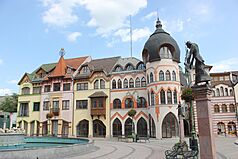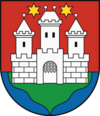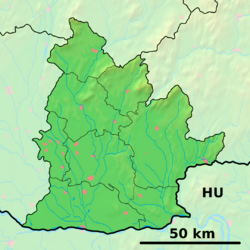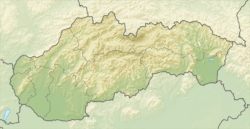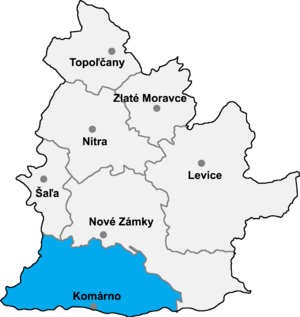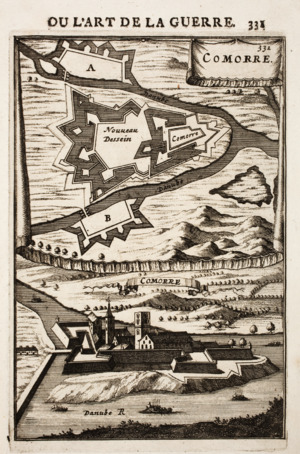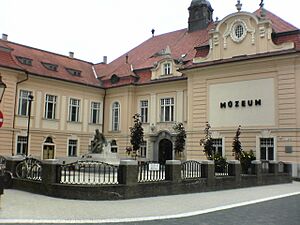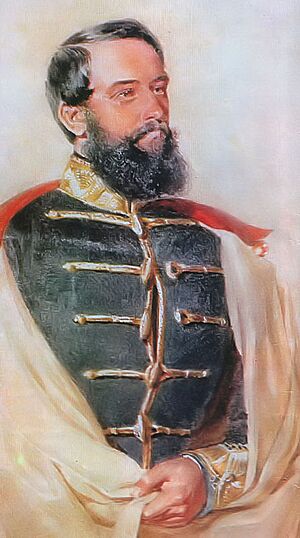Komárno facts for kids
Quick facts for kids
Komárno
Komárom
|
||
|---|---|---|
|
Municipality
|
||
|
From the top, Courtyard of Europe, Cultural and Social Centre of the Jewish Community of Komarno, Komárno Town Hall
|
||
|
||
| Country | ||
| Region | ||
| District | Komárno District | |
| First mentioned | 1075 | |
| Area | ||
| • Total | 103.17 km2 (39.83 sq mi) | |
| Elevation | 109 m (358 ft) | |
| Population
(2021)
|
||
| • Total | 32,287 | |
| Time zone | UTC+1 (CET) | |
| • Summer (DST) | UTC+2 (CEST) | |
| Postal code |
945 01
|
|
| Area code(s) | +421 35 | |
| Car plate | KN | |
Komárno is a town in Slovakia. It sits where the Danube and Váh rivers meet. This town has a very interesting history!
Komárno was once part of a single, larger town called Komárom. This town was split in half after World War I by the Treaty of Trianon. The northern part became Komárno in Slovakia, and the southern part became Komárom in Hungary.
Even though they are in different countries, Komárno and Komárom are still connected by the Elisabeth Bridge. A new road bridge also opened in 2020. Komárno is Slovakia's main port on the Danube River. It is also a key center for the Hungarian community in Slovakia. About 53.8% of the town's people are Hungarian.
Contents
What's in a Name? The Meaning of Komárno
The name Komárno might come from two different languages: Slavic or Latin.
Slavic Origin: "Mosquito Place"
- One idea is that the name comes from the Slavic word komár, which means "mosquito".
- The ending -no means "a place".
- So, Komárno could mean "a place with many mosquitos". This makes sense because it's near a swampy river area.
Latin Origin: "Trade Center"
- Another idea is that the name comes from the Latin word commercium.
- Commercium means "a trade center". This also makes sense because Komárno has always been an important trading spot.
The town's name has been written in many ways over time. In 1075, it was called Camarum. Later, it was known as Kamarn, Komarn, and Camaron. The Hungarian name for the town is Komárom. After the town was split, people started using names like Révkomárom (Komárom Port) or Észak-Komárom (North Komárom) to tell it apart from the Hungarian town.
A Journey Through Time: Komárno's History
Komárno is a very old settlement. People have lived here for thousands of years!
Ancient Times: Celts and Romans
- Early Settlers: Tools and items from the Stone Age and Bronze Age have been found here.
- Celtic Influence: Around the 1st Century BC, the Celts lived in this area.
- Roman Empire: In the 1st century AD, the Roman Empire took over this region. They built a military camp called Brigetio on the south side of the Danube.
- Fortifications: The Romans also built forts along the Danube to protect their land. One important fort was Celemantia, near present-day Iža. Some historians think there might have been a Roman fort where Komárno Castle is now.
- Barbarian Attacks: The Romans left the area by the end of the 4th century because of attacks from other tribes.
Medieval Times: Avars and Hungarians
- Avar Empire: After the Roman Empire, the Avars lived here in the 7th and 8th centuries. Many important Avar graves have been found in Komárno.
- Magyar Tribes: In the early 10th century, Magyar tribes took control. One chieftain, Ketel, and his son Alaptolma, are said to have built a castle here called Komárom.
- Hungarian State: When the Hungarian State was formed, Komárom Castle became the center of the Komárom county.
- Town Status: In 1265, King Béla IV gave Komárom special town rights. This helped the town grow with lots of trade and crafts.
- King Mathias Corvinus: The town did very well under King Mathias Corvinus. He built a palace in the castle and used the town as a base for his royal navy during wars against the Ottoman Empire.
Fortress and Disasters
- Defense Against Ottomans: In the 16th century, Komárom became a key defense point for the Habsburg Empire against the Ottomans.
- Old and New Fortresses: The medieval castle was rebuilt into a strong fort. Later, it was expanded to become the New Fortress. These forts successfully defended against Turkish attacks.
- Free Royal Town: In 1745, Empress Maria Theresa made Komárom a "free royal town." This meant it had special rights and grew even more.
- Natural Disasters: The 18th century brought many challenges, including floods, fires, and diseases. Two big earthquakes in 1763 and 1783 destroyed much of the town.
- Hungarian Revolution: Komárom played a big part in the Hungarian Revolution of 1848. It was the last place of Hungarian resistance against the Austrians. The town was badly damaged by Austrian attacks.
The 20th Century: A Divided Town
- Recovery and Growth: Komárom slowly recovered. In the late 1800s, new bridges and railway lines were built, making it an important transport hub.
- Town Split: After World War I, the Austro-Hungarian Empire broke apart. The Treaty of Trianon in 1920 split Komárom in two. The northern part became Komárno in Czechoslovakia (now Slovakia).
- New Identity: Komárno became a center for Hungarian culture in Czechoslovakia.
- World War II: During World War II, Komárno (then called Komárom again) was a military center. It was bombed several times, and the bridges were destroyed.
- Reconstruction: After the war, Komárno became part of Czechoslovakia again. The town rebuilt its industries, especially the SLKB Komarno - Slovak Shipyard Komárno. New factories and housing were built.
- Schengen Area: In 2007, Slovakia and Hungary joined the Schengen Area. This meant that border checks between Komárno and Komárom were removed, making it easier for people to travel between the two towns.
Explore Komárno: Must-See Sights
Komárno has many historical and cultural places to visit.
- Komárno Fortress: This huge system of forts was built from the 16th to the 19th century. It's one of the most important historical monuments in Slovakia and Hungary. It includes the Old Fortress and the New Fortress.
- Europe Place: This unique square features buildings designed in the style of 36 different European countries and regions. It's like a mini-Europe in one place! There's also a sculpture gallery with statues of famous historical figures.
- Danube Region Museum: Here you can learn about Komárno's history from ancient times to 1849. It has collections of Celtic, Roman, and Avar artifacts. You can also see old guild items and art from the 18th to 20th centuries.
- Calvinist Church: This church was built in a Classicist style in 1787. Its stone tower, built in 1832, was once the tallest point in town.
- Elisabeth Bridge: This historic bridge crosses the Danube River, connecting Komárno in Slovakia with Komárom in Hungary. It was named after the wife of King Schönbrunn. A line in the middle of the bridge marks the border between the two countries.
- Klapka Square and Town Hall: This main square used to be a small lake. The Town Hall has been rebuilt many times after fires and earthquakes. Since 1999, a figure of a hussar (a soldier) appears in the tower window every two hours on New Year's Eve, playing a song for the hero General György Klapka.
- Officer's Pavilion: This beautiful 19th-century building was once home to officers and their families who served in the Komárno fortress. The front of the building has the Latin phrase "VIRIBUS UNITIS," meaning "in unity is the power."
- Zichy Palace: Located on the main square, this palace has been used for many things over the centuries, including a theater, post office, and synagogue. Today, it houses part of the Danube Museum, with exhibits on local history and famous people from Komárno like Mór Jókai and Franz Lehár.
- Roman Lapidarium: This museum displays carved stone monuments from the 2nd to 4th centuries AD. These stones come from Roman forts that protected the border of the Roman Empire.
- St. Andreas Cathedral: The current church was completed in 1763 by the Jesuits. It was damaged by an earthquake and a fire but was rebuilt.
- St. Rozália Church: Built between 1839 and 1844, this church is in a Classicist style. In its courtyard, there is a Calvary with 14 stations.
- Statues of Famous People: You can find statues of many important figures in Komárno, including:
- Mór Jókai: A famous Hungarian writer, often called the "great storyteller."
- Ferenc Lehár: A well-known operetta composer.
- György Klapka: A general from the Hungarian Revolution.
- Ladislaus V: A Hungarian king born in Komárno in 1440.
- St. Stephan: The first Hungarian king.
- Statue of the Stone Virgin: This statue of a young girl is located in the New Fortress. It symbolizes that the fortress cannot be defeated. The Latin words "NEC ARTE NEC MARTE" underneath mean "Neither by trick nor by force."
- Synagogue: Built in 1896, this building complex is now the center of Jewish religious and cultural life in Komárno.
- The Water Tower: Built in 1902, this 28-meter-high tower stands on one of the highest points in town. It helps supply water to the town.
Fun Things to Do: Tourism in Komárno
Komárno offers many activities for visitors, especially those who love nature and history.
- Bicycle Tours Eurovelo 6: You can explore the beautiful Danube region by bike. This route offers stunning views, cultural sites, and local food.
- Komárno - Ecofarm Island Veľký Lél: Visit one of the last islands on the Danube. This eco-farm is great for families. You can go horse riding, have a picnic, or even camp.
- Komárno - Celemantia (Iža): Explore the remains of a Roman military camp from the 2nd century. It was part of the Roman Empire's border defense system.
- Komárno - Kravany nad Dunajom: Enjoy a promenade with a 16-meter-high lookout tower. There's also a park for bikers and a beach for swimming in warm weather.
- Boat, Kayak, and Canoe Rental: Komárno is perfect for water activities because it's at the meeting point of two big rivers. You can rent pedal boats, kayaks, and paddleboards on the Dead branch of the Váh river.
- Thermal Spa of Komárno: Relax in the thermal swimming pool, which has two natural hot springs. The mineral waters are good for your joints and muscles, and it's also a fun place to swim and play. In summer, there are beach areas, volleyball, and playgrounds.
- Ranch Holdas and Park: A few kilometers from Komárno, this ranch offers horse riding, archery, and outdoor meals. It's a great place for school trips or family events.
- Jumpland: A playful world designed for younger kids.
- Laser Arena Komárno: A fun place for laser tag games.
- Sightseeing Boat Tour: Take a boat tour between Komárno (Slovakia) and Komárom (Hungary) to see both towns from the river.
People and Culture in Komárno
Komárno is a diverse town with a rich cultural mix.
- Population: In 2021, Komárno had about 32,643 people. About 54% of the people are Hungarian, and 35% are Slovak.
- J. Selye University: In 2004, the first Hungarian-language university in Slovakia since 1919 was opened in Komárno.
- Serbian Community: The town has also been home to a Serbian national minority since the 15th century.
Famous Faces from Komárno
Many notable people were born or lived in Komárno:
- Richard Guyon (1813–1856), a British-born Hungarian general.
- Mór Jókai (1825–1904), one of Hungary's greatest writers.
- Hans Selye (1907–1982), a famous biologist.
- Franz Lehár (1870–1948), a well-known operetta composer.
- Ivan Reitman (1946–2022), a film producer and director.
- Ladislaus the Posthumous (1440–1457), King of Hungary, Bohemia, and Croatia.
Komárno's Sister Cities
Komárno has "twin towns" or "sister cities" around the world. These partnerships help promote cultural exchange and friendship.
- Blansko, Czech Republic
- Komárom, Hungary
- Kralupy nad Vltavou, Czech Republic
- Lieto, Finland
- Sebeş, Romania
- Terezín, Czech Republic
- Weissenfels, Germany
See also
 In Spanish: Komárno para niños
In Spanish: Komárno para niños


